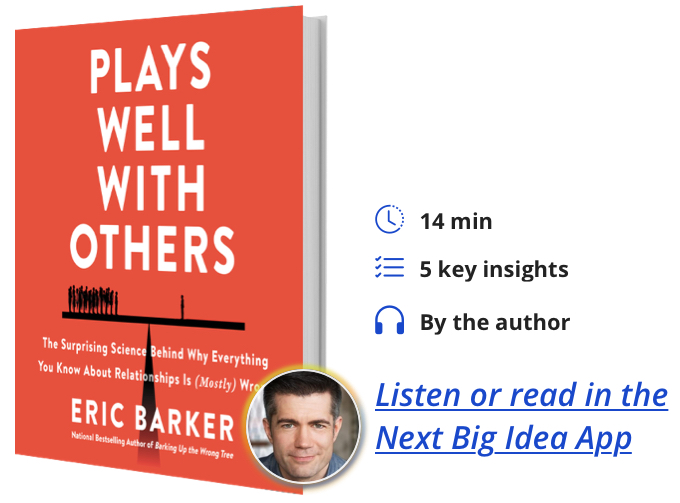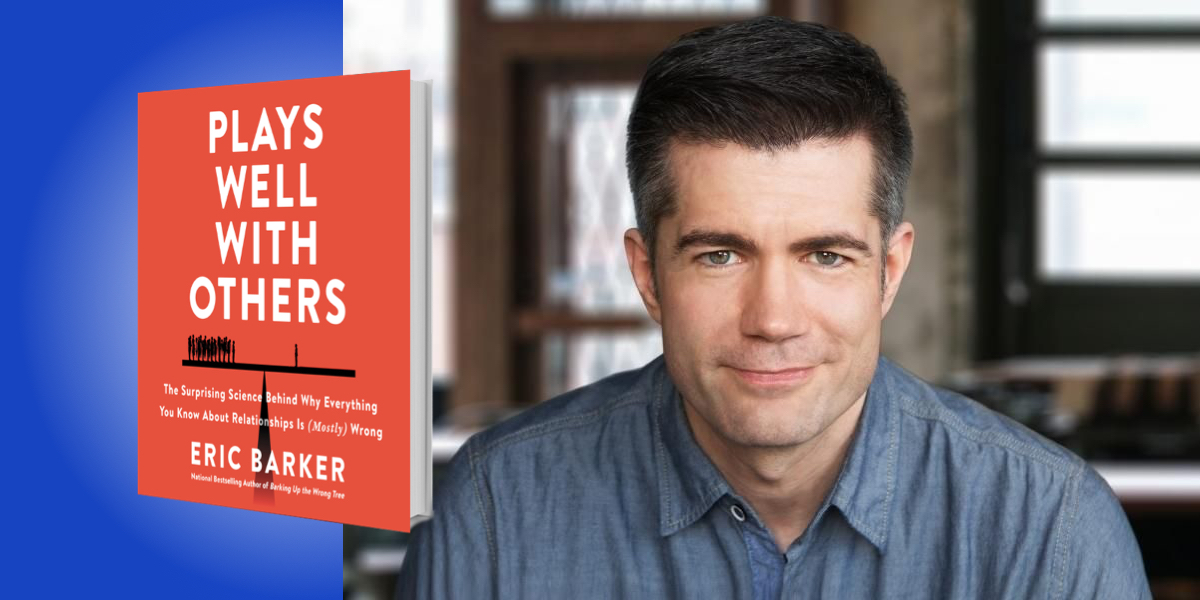Eric Barker is a writer and blogger whose work has appeared in the New York Times, The Atlantic, and The Financial Times. His first book, Barking Up the Wrong Tree, was a Wall Street Journal bestseller. His latest, Plays Well with Others, was praised by our curator Daniel Pink as “humorous and profound.”
Below, Eric shares 5 key insights from his new book, Plays Well with Others: The Surprising Science Behind Why Everything You Know About Relationships Is (Mostly) Wrong. Listen to the audio version—read by Eric himself—in the Next Big Idea App.

1. The secret to lie detection is making the other person think hard.
College students lie in about a third of conversations. For adults, it’s one in five. Whom do you lie to most frequently? That’s mom. You lie to your spouse the least, but you tell them the biggest lies, and you’re on the receiving end of about 200 a day. (This is not one of them, I promise.) Now there are a lot of myths around lie detection. A lot of people believe liars won’t look you in the eye, but that’s not true. Research says gaze aversion has never been shown to be a reliable indicator. In fact, a 1978 study of incarcerated psychopaths found they look people in the eyes more often than non-psychopaths when lying.
The biggest myth we deal with is that stress is an indicator of lying, but that’s never been shown to be true. Stress is what the polygraph detects, and one of the people who invented the polygraph was William Moulton Marston, who also created the DC Comics character Wonder Woman. Well, he probably should have stuck to that character’s lasso of truth, because it worked—and the polygraph doesn’t, according to research. The thing is, stress isn’t going to tell us who’s lying or not. People can get stressed for many different reasons, and we can’t be sure that a lie they may be telling is causing it. What does detect lies consistently is what’s called “cognitive load.” Basically, that means thinking hard.
Telling lies takes more cognitive horsepower than you might imagine. You need to think about the truth. You need to think about the lie you’re going to tell. You need to update the lie in real time. You need to make sure the other person’s not catching on. Lying takes a lot of thinking. So instead of asking yourself, “Is this person lying?” ask yourself, “Do they have to think hard?” A study by Aldert Vrij showed getting police officers to focus on the second question markedly improved their lie detection skills. So how could we do this most effectively? One tip is to use unanticipated questions that make someone think. A liar can’t prepare for every question that you might ask them. Research shows that airport security usually detect less than 5 percent of lying passengers, but when screeners used unanticipated questions, that number shot up to 66 percent.
How do we do this? Imagine you were a bartender, and someone comes into the bar who’s clearly underage. You might ask them how old they are, but they’re just going to say, “I’m 21.” What if you used an unanticipated question? Instead of asking their age, ask “What year were you born?” That’s a really easy question for someone telling the truth to answer, but it’s harder for a liar. They’re going to have to think for a second, and probably do some math. They’re going to slow down. That’s going to be obvious, and it’s going to be much easier to detect their lies. So when you think someone’s lying, ask an unanticipated question.
You can also try asking a question that could be verified. If someone says, “I was at that meeting yesterday,” you could say, “Was Carol wearing that scarf she always wears?” A liar knows this is dangerous. This is something that could be verified. This is something you can check on. Asking unanticipated questions that make liars think hard is a great way to get closer to the truth.
“Instead of asking yourself, ‘Is this person lying?’ ask yourself, ‘Do they have to think hard?’”
2. What Dale Carnegie got wrong about making friends.
We don’t give friendship enough credit. A 2008 Journal of Socio-Economics study found that while changes in income provide only a minor increase in happiness, more time with friends boosts your smiling to the equivalent of an extra $97,000 a year. Do you have three friends at work? If so, you’re 96 percent more likely to say you’re happy about your life. Not your job—your life.
What predicts whether you’ll be alive one year after a heart attack? Two things: how many friends you have, and whether you smoke. Oxford professor Robin Dunbar says you can eat as much as you like, you can slob about, you can drink as much alcohol as you like. The effect is very modest compared with those other two factors. Now, most of what people know about friendship comes from Dale Carnegie, but Dale Carnegie wrote his book long before the advent of social science research. So does what he said really hold up under the scrutiny of science? Turns out most of it does.
But Carnegie did get one thing wrong.
He said we should try and see things from the other person’s perspective. Yet research shows we’re terrible at this. Professor Nicholas Epley has found that with strangers, you correctly detect their thoughts and feelings only 20 percent of the time. With close friends you only hit 30 percent, and married couples peak at 35 percent. Whatever you think is going on in your spouse’s head, two-thirds of the time, you’re wrong. If you want to know what people are thinking, you need to ask them.
More importantly, Carnegie’s advice is really only good for the beginning of relationships. To deepen friendships, we need to remember two things Carnegie didn’t talk about: time and vulnerability.
Time is crucial when it comes to relationships. Time is always scarce, and giving someone your time shows them that they’re someone you care about. Researchers from the University of Notre Dame analyzed over 8 million phone calls and found that touching base in some form every two weeks is a good target to shoot for. Hit that minimum frequency, and friendships are more likely to persist.
Vulnerability—that’s opening up, sharing your fears, concerns, and worries. Often we don’t like to do this. We don’t want to look weak or silly. But the truth is, when we share our fears and concerns, we become more three-dimensional. It shows the other person we trust them because we’re talking about things that could make us look bad. Importantly, this is how people really get to know us. Vulnerability is critical, and not being open and vulnerable doesn’t just kill friendships—it can also kill you. University of Pennsylvania professor Robert Garfield notes that not opening up prolongs minor illnesses. It increases the likelihood of a first heart attack, and it doubles the chance that heart attack will be lethal.
For bonus points, introduce your friends to each other. Having friendships is great, but having a community is even better. A 2020 study found that we feel the most support from friends when they’re connected to one another. Feeling loved by five separate pals is less loving than feeling connected to five mutual pals.
“Touching base in some form every two weeks is a good target to shoot for. Hit that minimum frequency, and friendships are more likely to persist.”
3. Start romantic discussions gently.
It’s a cliché, but you really do need to communicate. Difficult relationship conversations need to happen. Researcher John Gottman quipped, “If you’re in a committed relationship and you haven’t yet had a big argument, please do that as soon as possible.” Fighting doesn’t end marriages—not communicating ends marriages. Escalating, shouting matches only lead to divorce 40 percent of the time. More often than not, marriages end with a whimper, not a bang. You scream because you care, and once you stop caring, you stop arguing, and then people start living parallel lives, a progression that can lead to divorce. 69 percent of ongoing marital problems never get resolved. This might sound depressing, but that stat is true of both happy and unhappy marriages. The point is that it’s not what you talk about—it’s how you talk about it.
As Gottman notes, it’s the way that you don’t solve problems that matters. It’s about the regulation—not the resolution—of the conflict. There are some issues that you’re just never going to resolve. That’s fine. But don’t get nasty. Don’t get mean. That’s what really sustains a relationship—you need to talk. Research shows complaining is actually healthy for a marriage. It’s criticism that predicts divorce. Complaining is when I say, “You didn’t take the trash out.” Criticism is when I say, “You didn’t take the trash out because you’re a horrible person.” To keep your relationship solid, address the event, not the person.
The key point here is to start your relationship discussions gently. Just by listening to the first three minutes of an argument, Gottman could predict the result 96 percent of the time. If it starts harsh, it’s going to end harsh—and harsh startups not only predicted the outcome of the conversation; they also predicted divorce. If you can start relationship discussions gently, you’re doing your relationship a huge service. If you can, show a little bit of compassion, kindness, and warmth during the argument. A 2001 study found that people who are compassionate with their partner in the middle of an argument have 34 percent fewer of them, and those arguments last half as long.
4. The secret to making love last is excitement.
After the first four years of marriage, satisfaction drops an average of 15 to 20 percent. Imagine your salary doing that. How personally happy are most people two years after getting married? Richard Lucas at Michigan State University found that they’re about as happy as they were before they got married. The best predictor of a relationship lasting is a positive illusion, being positively biased towards your partner. In the early stage of love, when you saw them as the most amazing person ever, you saw them as better than they really are. That idealization is the hallmark of love, and it predicts the future of relationships better than just about anything. If you’re about to walk down the aisle, you had better be feeling crazy love. Women who have second thoughts before they say “I do” are two-and-a-half times more likely to be divorced in four years. For men, it’s more than a 50 percent increase.
“You fell in love because you did fun, exciting stuff, and if you keep doing those things, you can make love last.”
We need to keep that positive bias going—but what’s the best way to do that? Do exciting things together. Researchers found couples who went out to dinner or a movie didn’t get nearly the marital satisfaction boost that those who danced, skied, or went to concerts did. This is due to the psychological principle of emotional contagion. Whatever emotion we’re feeling in an environment or context, we’re going to associate that with the person we’re with. When you and your partner do fun, exciting stuff together, you unconsciously associate that fun and excitement with each other.
So, never stop dating. Keep doing fun stuff. You fell in love because you did fun, exciting stuff, and if you keep doing those things, you can make love last.
5. Loneliness isn’t about being alone.
Even before the 2020 pandemic, 75 percent of doctors in the United Kingdom said they saw patients every day whose main complaint was loneliness. In 2017, the problem got so bad that the country appointed a Minister of Loneliness. The number of people in the United States who report feeling lonely stands, according to one study, at around 62 million. That’s the entire population of the UK.
Loneliness is a very serious problem. It’s correlated with pretty much every negative health metric you can imagine. John Cacioppo’s research has shown that loneliness is the emotional equivalent of a physical assault. The elevation in stress hormones is comparable to what you would experience by someone punching you in the face.
But here’s the crazy thing: a 2003 study by Cacioppo showed that, on average, lonely people spend as much time with other people as non-lonely people do. Sound crazy? That’s what I thought, too. But here’s the thing: loneliness is a subjective feeling. It’s not necessarily about physical isolation. We know this—we’ve all felt lonely in a crowd. Loneliness doesn’t care if you’re actually alone, because loneliness is how you feel about your relationships. If you have deep relationships, you can travel. You can be away from friends and family, and you don’t feel alone. You don’t feel lonely. You don’t feel disconnected. But if you have weak relationships, you can be surrounded by other people and still feel like you’re all by yourself.
So if you’re feeling lonely, try to become part of a community. Join a group. Form a group. Volunteer. Sadly, we don’t do those things as much as we used to. Between 1980 and 2005, the number of times Americans invited friends to their house declined by half. Club participation dropped by two-thirds in the three decades after 1975. And we’re experiencing severe picnic deprivation! Picnics are down 60 percent over the same time period.
We need to feel like we’re part of a group. We need to deepen those friendships with time and vulnerability. Loneliness isn’t just about how much time you spend with other people. It’s about deepening those relationships so that even when you’re away from those you love, you still feel that you have a strong connection to them.
To listen to the audio version read by author Eric Barker, download the Next Big Idea App today:































